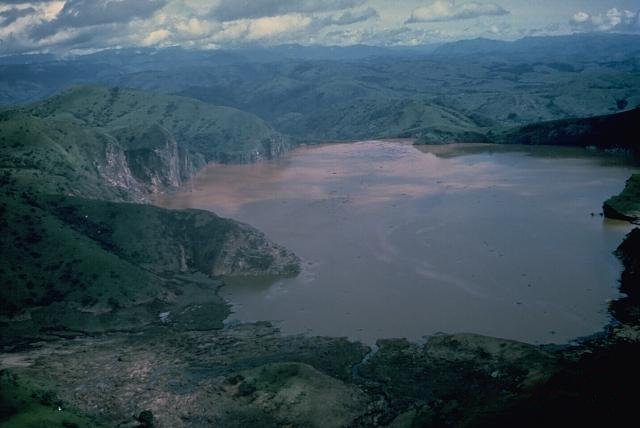The Lake That Killed Its Neighbors

Lake Nyos, pictured above, is located in western Cameroon, tucked away near the Nigerian border. (Here’s a map.) It’s the byproduct of an extinct volcano which erupted about 400 years ago, and since then, people have been settling near its shores. That, unfortunately, has lead to tragic results. Over a few hours in August of 1986, 1,700 of those residents lost their lives. They had all suffocated.
What happened? The lake had erupted.
Yes, lakes can erupt — it’s called a “limnic eruption” or a “lake overturn.” The science behind it is a lot like what happens when a shaken can of soda opens suddenly — it explodes, with carbon dioxide bubbles rapidly escaping. In the case of lakes, though, it’s much, much worse. Something at the bottom of the lake — in this case, likely volcanic gas — leaks carbon dioxide into the water. CO2 dissolves into water more readily than usual under certain conditions: when the water is under high pressure and when its temperature is both cold and generally stable. Those conditions are present for the soda in a soda can, but it’s also the case for the water at the bottom of some lakes. The deep water areas become saturated with CO2 — until something happens, causing the trapped gas to escape upward.
In the case of a can of soda, the gas escapes when someone pops it open or when it becomes sufficiently agitated. The same principles are true for lakes with a high amount of gas dissolved at lower depths — things like earthquakes or volcanic activity can trigger a limnic eruption. In the case of Lake Nyos, that massive release of carbon dioxide occurred on August 21, 1986, for reasons unclear. (One theory is that a landslide preceded the eruption, but there is far from any agreement on that.) The CO2 — which is heavier than air — flooded the surrounding areas and crowded out the breathable, oxygen-rich air. Nearly 2,000 people died, including all but six people from one village which, according to Slate, had 800 residents before the disaster. It was only the second known time that such a limnic eruption occurred — the previous one was two years early at another lake in Cameroon, Lake Monoun, claiming the lives of 37 nearby residents.
Scary stuff, but if you live near a lake, you almost certainly don’t have to worry about this happening to it. The lake would need to have a gas source, be very deep, and also very still. And that’s only true for three lakes in the world — the aforementioned Nyos and Monoun in Cameroon, and Lake Kivu on the border of the Democratic Republic of Congo and Rwanda.
Bonus Fact: A limnic eruption of Lake Kivu could make the death toll from the Lake Nyos eruption look tiny; roughly 2 million people live near its shores. However, an explosion is unlikely, because scientists have undertaken efforts called “degassing,” removing a lot of the risk by removing a lot of the gas. As a bonus, the gas in Lake Kivu isn’t carbon dioxide — it’s methane. According to CNN, the Rwandan government has been working on a way to capture the methane and turn it into a power source.
From the Archives: Lightning Lake: Probably the coolest lake in the world.
Related: “A Young Scientist’s Guide to Defying Disasters with Skill and Daring: Includes 20 Experiments for the Sink, Bachtub and Backyard” by James Doyle. It has a chapter on limnic eruptions and looks kind of cool, too. Three reviews averaging 5 stars. And yes, Amazon has the title as “Bachtub,” so I decided to leave it like that.
